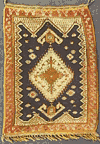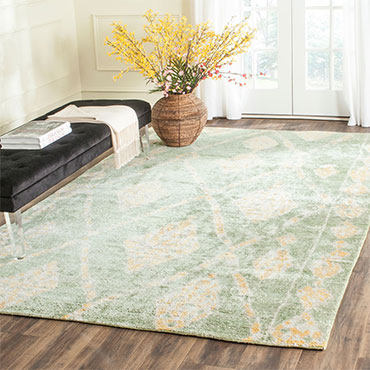

 Moroccan rugs generally have bright bands of color alternating with bands exhibiting geometric and mound like forms. They are frequent in Moroccan rug flat weaves and evoke desert scenes.
Moroccan rugs generally have bright bands of color alternating with bands exhibiting geometric and mound like forms. They are frequent in Moroccan rug flat weaves and evoke desert scenes.
Years ago women had more time to create colorful rugs and carpets, mixing different plants from the Atlas Mountains to find a special color. They tried to create a piece of art better than their neighbor. Rugs and carpets had many functions within the family. The rugs were not only used as cover, but as an element of prestige between the tribes, a means of communication to express suffer and harshness of the countryside. While reading the carpets made throughout Morocco, you can live the saga of the old generations, their life style, values, and morals. The geometric forms, and the choice of color reflect the mood of the woman-artist who put this combination together. These enigmatic, geometric forms will be found in the old jewelries and old Kasbahs, which remains the clues of unsolved civilization. Nowadays few families live on carpets as before. The old quality of the rug does not exist anymore with some exceptions to modernized styles with artificial raw materials. The producers have to adapt the new features of the market apposed by an economy based on tourism.
Moroccan carpets are somewhat unappreciated and perhaps misunderstood by many rug collectors, due to any number of factors, such as the ubiquity of blatant synthetic dyes, seeming rote and monotonous repetitive banded patterns, and misinterpretation of a weave which may seem loose and shabby in comparison to more traditional Middle Eastern work.
It does seem that a great percentage of Moroccan carpets are of the coarse weave and lurid dye variety, a quality which could be ascribed to Morocco's close proximity to the west, with its availability of inexpensive artificial dyes and perhaps even more importantly its being a major tourist destination with a virtual tidal wave of airport art quality weaving generated in pursuit of the souvenir trade.
But there are interesting, strikingly beautiful, authentic, and valuable weavings to be found among the everyday - and of course not everyday - yet just as with their Middle Eastern counterparts, it is a familiarity with designs, materials, techniques, and formats that allow one to distinguish the average from interesting and exemplary.
Disclaimer: The information provided in this article is for general informational purposes only. While we strive to ensure the accuracy and reliability of the information presented, we make no warranties, express or implied, about the completeness, accuracy, reliability, suitability, or availability with respect to the content. Any reliance you place on such information is strictly at your own risk. We recommend consulting with professionals for specific advice tailored to your project’s needs, particularly regarding building codes, regulations, and product specifications.
Under no circumstances shall we be liable for any loss or damage, including without limitation, indirect or consequential loss or damage, arising from the use of, or reliance on, the information provided in this article.



